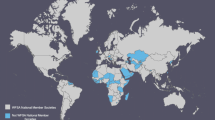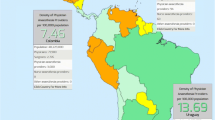Abstract
There is a growing consensus that surgical disease will eclipse infectious disease as a global healthcare issue in the next 10 years. However, anesthesia resources are extremely limited in low and middle-income countries. Funds for anesthesia are limited. Trained providers are scarce. Many providers migrate to highincome countries for economic and professional reasons. Lack of equipment, pharmaceuticals and infrastructure for the provision of safe anesthesia also limit anesthesia delivery. This chapter details each of these factors.
Access this chapter
Tax calculation will be finalised at checkout
Purchases are for personal use only
Similar content being viewed by others
References
UN Millennium Summit (6–8 September 2000). http://www.un.org/en/events/pastevents/millennium_summit.shtml. Accessed Mar 20 2014.
Agency for Healthcare Research and Quality: “Addressing health disparities: a conversation with Thomas LaVeist, PhD, Director of the Hopkins Center for Health Disparities Solutions at the Johns Hopkins Bloomberg School of Public Health”. 04–17 2013, Accessed 20 Mar 2014.
UN Millennium Development Goals Report 2013. http://www.un.org/millenniumgoals/pdf/report-2013/mdg-report-2013-english.pdf. Accessed 20 Mar 2014.
Jamison D, World Bank. Disease control priorities project. Disease control priorities in developing countries. Washington, DC: Oxford University Press/World Bank; 2006.
Farmer P, Kim JY. Surgery and global health: a view from beyond the OR. World J Surgery. 2008;32(4):533–6.
Abdullah F, Troedsson H, Cherian M. The World Health Organization Program for emergency surgical, obstetric and anesthetic care: from Mongolia to the future. Arch Surg. 2011;146:620–3.
WHO: Emergency and essential surgical care. http://www.who.int/surgery/globalinitiative/en/. Accessed 20 Mar 2014.
Médecins Sans Frontières: MSF Activities. http://www.msf.org/msf-activities. Accessed 20 Mar 2014.
Glenshaw M, Madzimbamuto FD. Anaesthesia associated mortality in a district hospital in Zimbabwe: 1994–2001. Cent Afr Med. 2005;51:39–44.
McCord C, Chowdhury Q. A cost effective small hospital in Bangladesh: what it can mean for emergency obstetric care. Int J Gynaecol Obstet. 2003;81:83–92.
Curci M. Task shifting overcomes the limitations of volunteerism in developing nations. Bull Am Coll of Surg. 2012;97(10):9–14.
Laleman G, Kegels G, Marchal B, Van der Roost D, Bogaert I, Van Damme W. The contribution of international health volunteers to the health workforce in sub-Saharan Africa. Hum Res Health. 2007;5:19–27.
World Bank. How we classify countries. http://data.worldbank.org/about/country-classifications. Accessed 20 Mar 2014.
CMS.GOV. National health expenditures 2012 highlights. http://www.cms.gov/Research-Statistics-Data-and-Systems/Statistics-Trends-and- Reports/NationalHealthExpendData/downloads/highlights.pdf. Accessed 20 Mar 2014.
World Bank. Health expenditure per capita (Current US$). http://data.worldbank.org/indicator/SH.XPD.PCAP Accessed 20 Mar 2014.
World Bank. GNI per capita ranking, Atlas method and PPP. http://data.worldbank.org/data-catalog/GNI-per-capita-Atlas-and-PPP-table. Accessed 20 Mar 2014.
Scheffler RM, Jiu JX, Kinfu Y, Dal Poz MR. Forecasting the global shortage of physicians: an economic-and needs-based approach. Bull World Health Organ. 2008;86:516–23.
Weiser TG, Regenbogen SE, Thompson KD, Haynes AB, Lipsitz SR, Berry WR, Gawande AA. An estimation of the global volume of surgery: a modeling strategy based on available data. Lancet. 2008;372:139–44.
CDC: Fast facts—inpatient surgery. http://www.cdc.gov/nchs/fastats/insurg.htm. Accessed 20 Mar 2014.
American society for Aesthetic Plastic Surgery 2012. http://www.surgery.org/media/statistics. Accessed 20 Mar 2014.
Braz LG, Braz DG, Braz JRC. Mortality in anesthesia: a systematic review. Clinics (Sao Paolo). 2009;64(10):999–1006.
Yii MK, Ng KJ. Risk-adjusted surgical audit with the POSSUM scoring system in a developing country. Br J Surg. 2002;89:110–3.
World Alliance for Patient Safety, WHO Guidelines for Safe Surgery (First Edition), 2008. 9–10.
Funk LM, Weiser TG, Berry WR, Lipsitz SR, Merry AF, Enright AC, Wilson IH, Dziekan G, Gwande AA. Global operating theatre distribution and pulse oximetry supply: an estimation from reported data. Lancet. 2010;376:1055–61.
Warner MW. Efforts Needed to Meet Anesthesiologist Demand. Physicians Weekly; 2011.
Walker I, Wilson I, Bogod D. Anaesthesia in developing countries. Anaesthesia. 2007;62 Suppl 1:2–3.
Hodges SC, Mijumbi C, Okello M, McCormick BA, Wlaker IA, Wilson IH. Anaesthesia services in developing countries: defining the problems. Anaesthesia. 2007;62:4–11.
Vo D, Cherian MN, Bianchi S, et al. Anesthesia capacity in 22 low and middle income countries. J Anesth Clin Res. 2012;3(4):207–11.
Conway MD, Gupta S, Prakash S. Building better partnerships for global health. McKinsey Quarterly; 2006, p. 1–8.
Mullan F. The metrics of the physician brain drain. NEJM. 2005;353:1810–8.
US Senate Committee on Foreign Relations, Testimony of Dr. Dr. Paul Farmer, July 15 2003.
Forum Libre I: Medecine, Sante et Democratie en Haiti. 1989, p. 11–20.
WHO, Maternal Mortality Fact Sheet, Fact sheet N°348, May 2012. http://www.who.int/mediacentre/factsheets/fs348/en/. Accessed 20 Mar 2014.
Notrica MR, et al. Rwandan surgical and anesthesia infrastructure: a survey of District Hospitals. World J Surg. 2011;35:1770–80.
World Health Organization, “Global Atlas of the Health Workforce”. http://who.int/hrh/statistics/hwfstats/en/index.html. Accessed 20 Mar 2014.
Spiegel DA, Choo S, Cherian M, et al. Quantifying surgical and anesthetic availability at primary health facilities in Mongolia. World J Surg. 2011;35:272–9.
Daugherty, et al. An analysis of the labor markets for anesthesiology. Santa Monica, CA: RAND Corporation; 2010.
Cristina Frangou, “Tensions Rise in Debate on Role of Europe’s CRNAs”. Anesthesiology News. 2007.
John Hayes, “Anesthesiologist-CRNA Teamwork Common, but Groups at Odds,” Medscape Anesthesiology. 2012.
Tuffs A. German Hospital’s use of trained nurse anaesthetists angers doctors. BMJ. 2007;334(7594):607.
American Society of Anesthesiologists, “About the Profession”. http://www.asahq.org/For-the-Public-and-Media/About-Profession.aspx. Accessed 20 Mar 2014.
American Association of Nurse Anesthetists, “Certified Registered Nurse Anesthetists at a Glance”. http://www.aana.com/ceandeducation/becomeacrna/Pages/Nurse-Anesthetists-at-a-Glance.aspx. Accessed 20 Mar 2014.
British Anaesthetic and Recovery Nurses Association, “Becoming an Anaesthetic and Recovery Nurse”. http://www.barna.co.uk/media/uploads/downloads/how-to-become-an-anaesthetic-and- recovery- nurse.pdf. Accessed 20 Mar 2014.
The Royal College of Anaesthetists, “Considering a Career in Anaesthesia”. http://www.rcoa.ac.uk/careers-and-training/considering-career-anaesthesia. Accessed 20 Mar 2014.
Global Knowledge Exchange Network, An overview of education and training requirements for global healthcare professionals: nursing edition. 2009.
International Federation of Nurse Anesthetists, “About IFNA”. http://ifna-int.org/ifna/page.php?16. Accessed 20 Mar 2014.
Australian and New Zealand College of Anaesthetists, “What is anaesthesia?” http://www.anzca.edu.au/patients/anaesthestist. Accessed 20 Mar 2014.
Global Knowledge Exchange Network, An overview of education and training requirements for global healthcare professionals: physician edition. 2009.
Newton M, Bird P. Impact of parallel anesthesia and surgical provider training in sub-Saharan Africa: a model for a resource-poor setting. World J Surg. 2010;34:445–52.
Ryan Greysen S, et al. Medical education in Sub-Saharan Africa: a literature review. Med Edu. 2011;45:973–86.
“Sweden Contributes $30m to 3MDG Fund,” Mizzima. 2014.
WHO Country Office for Nepal, “Human Resource for Health (HRH),” WHO. 2008. http://www.nep.searo.who.int/EN/Section4/Section40.htm.
World Federation for Medical Education, “Standards”. WFME. 2014. http://www.wfme.org/standards. Accessed 20 March 2014.
“European Diploma in Anaesthesiology and Intensive Care”. European Society of Anaesthesiology. 2012. http://www.esahq.org/education/edaic/about.
World Health Organization: Guide to infrastructure and supplies at various levels of health care facilities—Emergency and Essential Surgical Care (EESC), Compiled from the WHO Manual Surgical Care at the District Hospital 2003. WHO/HPW/CPR 2005.
Rosseel P, Trelles M, Guilavogui S, Ford N, Chu K. Ten years of experience training non-physician anesthesia providers in Haiti. World J Surg; 2010;34:453–8.
Shrestha BM, Rana NB. Training and development of anesthesia in Nepal: 1985 to 2005. Can J Anesth. 2006;53(4):339–43.
AMA International Health Database. http://www.ama-assn.org//ama/pub/about-ama/our- people/member-groups-sections/medical-student-section/opportunities/international-health- opportunities.page. Accessed 20 Mar 2014.
Curci M. Task shifting overcomes the limitations of volunteerism in developing nations. Bull Am Coll Surg. 2012;97(10):9–14.
Laleman G, Kegels G, Marchal B, Van der Roost D, Bogaert I, Van Damme W. The contribution of international health volunteers to the health workforce in sub-Saharan Africa. Human Resources for Health. 2007;5:19–27.
Mullan F. The metrics of the physician brain drain. New Eng J Med. 2005;353:1810–8.
Clemens MA, Pettersen G. New data on African health professionals abroad. Hum Res Health. 2007;6(1).
Hagopian A, et al. The migration of physicians from sub-Saharan Africa to the United States of America: measures of the African brain drain. Hum Res Health. 2004;2(17).
DeCamp M, Rodriguez J, Hecht S, Barry M, Sugarman J. An ethics curriculum for short term global health trainees. Global Health. 2013;9:5.
Goucke R, Morriss W. “Pain management in low and middle income countries—just put up with it?” Anaesthesia News. 2011. 293, p. 6.
Personal communication, Brett Gutsche.
Tobias JD, Columbia M, Kim Y, Davis J (2002) Anesthetic care in developing countries: equipment and techniques. South Med J. 95(2): 239–247.
Shinde G, Sharma N, Jadhav B, Jaisal P. Caesarean section under local anaesthesia: back to basics. Trop Doct. 2012;42:38–40.
Zafar A, Ahmad S, Ansari J. Office haemorrhoidectomy with local anaesthesia: a feasible day-case procedure. Trop Doct. 2009;39:69–70.
Munks DG, Alli MO, Abdel Goad EH. Optical urethrotomy under local anaesthesia is a feasible option in urethral stricture disease. Trop Doct. 2010;40:31–312.
Craven R. Ketamine. Anaesthesia. 2007;62 Suppl 1:48–53.
We Care Solar. http://wecaresolar.org/. Accessed 20 Mar 2014.
University of Utah, Technology venture development, P. 10–11. http://www.techventures.utah.edu/Documents/Student-Innovation-Report-2013.pdf. Accessed 20 Mar 2014.
National Academy of Sciences, The Global Health and Education Foundation. http://www.drinking-water.org/. Accessed 20 Mar 2014.
Congo Story. HEAL Africa Water Project. http://congostory.org/node/86?page=1. Accessed 20 Mar 2014.
Howie SR, Hill S, et al. Meeting oxygen needs in Africa: an options analysis from Gambia. Bull World Health Org. 2009;87:763–71. http://who.int/bulletin/volumes/87/10/08-058370/en/index.html. Accessed 20 Mar 2014.
Mavalankar D, et al. Managing equipment for emergency obstetric care in rural hospitals. Int J Gynaecol Obstet. 2004;87(1):88–97.
Howitt P, et al. The lancet and imperial college London (UK) commission: technologies for global health. Lancet. 2012;380(9840):507–35.
Health Partnership Scheme, Partnership for Global Health. http://www.thet.org/hps/. Accessed 20 Mar 2014.
Health Partners International. “How to Manage” series of health care technology guides. http://www.healthpartners-int.co.uk/our_expertise/how_to_manage_series.html. Accessed 20 Mar 2014.
Lifebox. http://www.lifebox.org/about-lifebox/the-pulse-oximetry-gap/. Accessed 20 Mar 2014.
Gradian Health Systems. http://www.gradianhealth.org/wp-content/uploads/2012/03/Gradian- Brochure-FULL-revised-4.23_reduced-size1.pdf. Accessed 20 Mar 2014.
Diamedica. http://www.diamedica.co.uk/english/product_details.cfm?id=208. Accessed 20 Mar 2014.
Buck N, Devlin HB, Lunn JN. The report of a confidential enquiry into perioperative deaths. London: Nuffield Provincial Hospitals Trust and the King’s Fund; 1987.
Heywood AJ, Wilson IH, Sinclair JR. Perioperative mortality in Zambia. Ann R Coll Surg Eng. 1989;71:354–8.
Hansen D, Gausi SC, Merikebu M. Anaesthesia in Malawi: complication and deaths. Trop Doctor. 2008;30:146–9.
Enohumah KO, Imarengiaye CO. Factors associated with anaesthesia-related maternal mortality in a tertiary hospital in Nigeria. Acta Anaesthesiol Scand. 2006;50:206–10.
Ouro-Gang’na Maman AF, Tomta K, Ahouangbevi S, Chobli M. Deaths associated with anaesthesia in Togo, West Africa. Trop Doct. 2005;35:220–2.
Debas HT, Gosselin R, McCord C, et al. Surgery. In: Jamison DT, Breman JG, Measham AR, et al., editors. Disease control priorities in developing countries. 2nd ed. Washington, DC: World Bank; 2006. Chapter 67Available from: http://www.ncbi.nlm.nih.gov/books/NBK11719/.
WHO Road Traffic Data. http://www.who.int/mediacentre/factsheets/fs358/en/. Accessed 25 Mar 2014.
WHO Data on Pregnancy-Related Complications and Death. http://www.who.int/mediacentre/factsheets/fs348/en/. Accessed 25 Mar 2014.
WHO Data on Club Feet. http://www.who.int/surgery/challenges/esc_congenital_nomalies/en/. Accessed 25 Mar 2014.
The World Bank. Knowledge in development note: international migration. 2009. http://econ.worldbank.org/WBSITE/EXTERNAL/EXTDEC/EXTRESEARCH/0,,content MDK:22451777~pagePK:64165401~piPK:64165026~theSitePK:469382~isCURL:Y,00. html. Accessed 25 Mar 2014.
Dubowitz G, Detlefs S, McQueen KA. Global anesthesia workforce crisis: a preliminary survey revealing shortages contributing to undesirable outcomes and unsafe practices. World J Surg. 2010;34(3):438–44. doi:10.1007/s00268-009-0229-6.
Maki J, Qualls M, White B, Kleefield S, Crone R. Health impact assessment and short-term medical missions: a methods study to evaluate quality of care. BMC Health Ser Res. 2008;8:121. doi:10.1186/1472-6963-8-121.
Acherman LK. The ethics of short-term international health electives in developing countries. Ann Behav Sci Med Edu. 2010;16(2):40–3.
Perry L, Malkin R. Effectiveness of medical equipment donations to improve health systems: how much medical equipment is broken in the developing world? Med Biol Eng Comput. 2011;49:719–22. doi:10.1007/s11517-011-0786-3.
Author information
Authors and Affiliations
Corresponding author
Editor information
Editors and Affiliations
Rights and permissions
Copyright information
© 2015 Springer International Publishing Switzerland
About this chapter
Cite this chapter
Boggs, S.D., Chee, N.W. (2015). Anesthesia Disparities Between High-Income Countries and Low-and Middle-Income Countries: Providers, Training, Equipment, and Techniques. In: Roth, R., Frost, E., Gevirtz, C., Atcheson, C. (eds) The Role of Anesthesiology in Global Health. Springer, Cham. https://doi.org/10.1007/978-3-319-09423-6_4
Download citation
DOI: https://doi.org/10.1007/978-3-319-09423-6_4
Published:
Publisher Name: Springer, Cham
Print ISBN: 978-3-319-09422-9
Online ISBN: 978-3-319-09423-6
eBook Packages: MedicineMedicine (R0)




